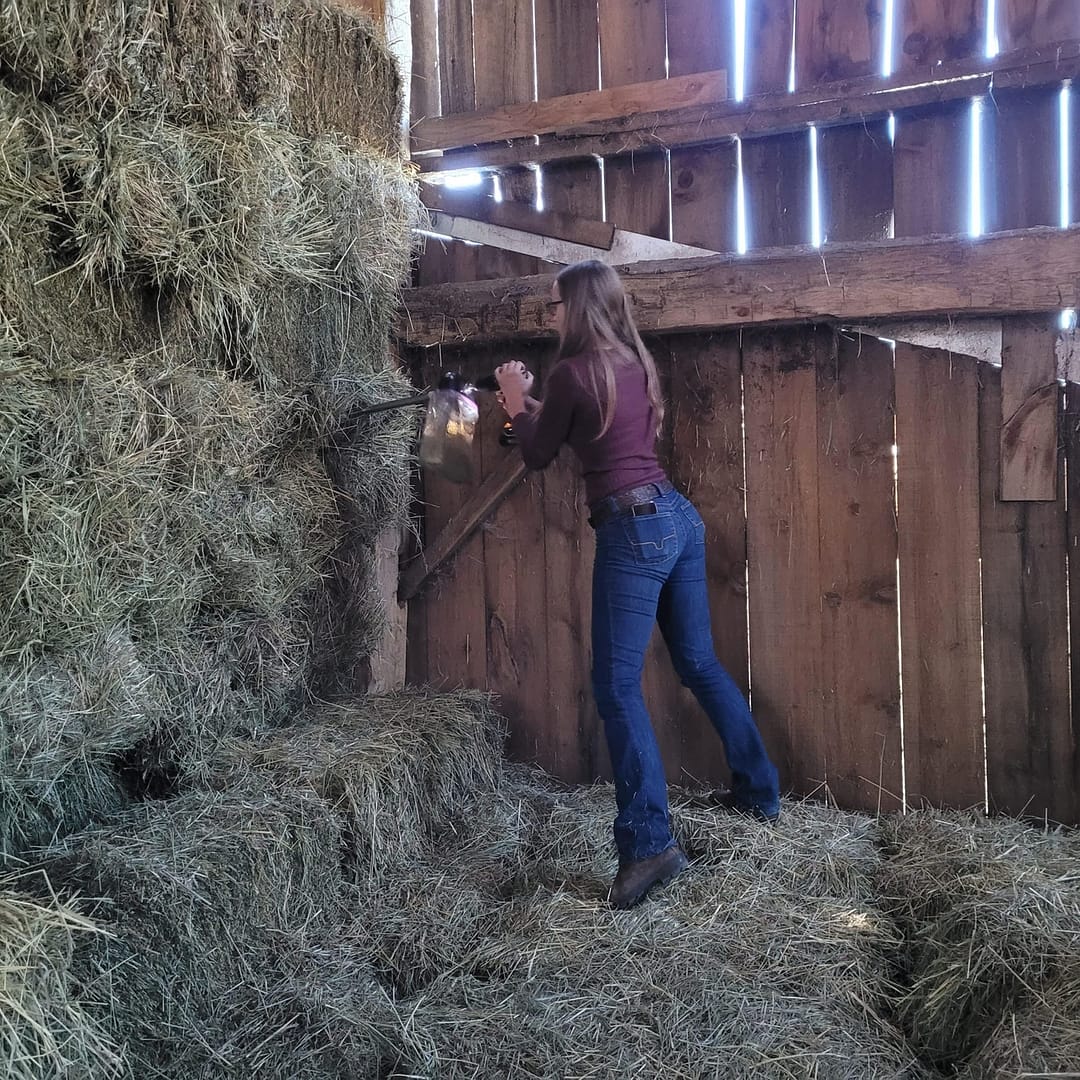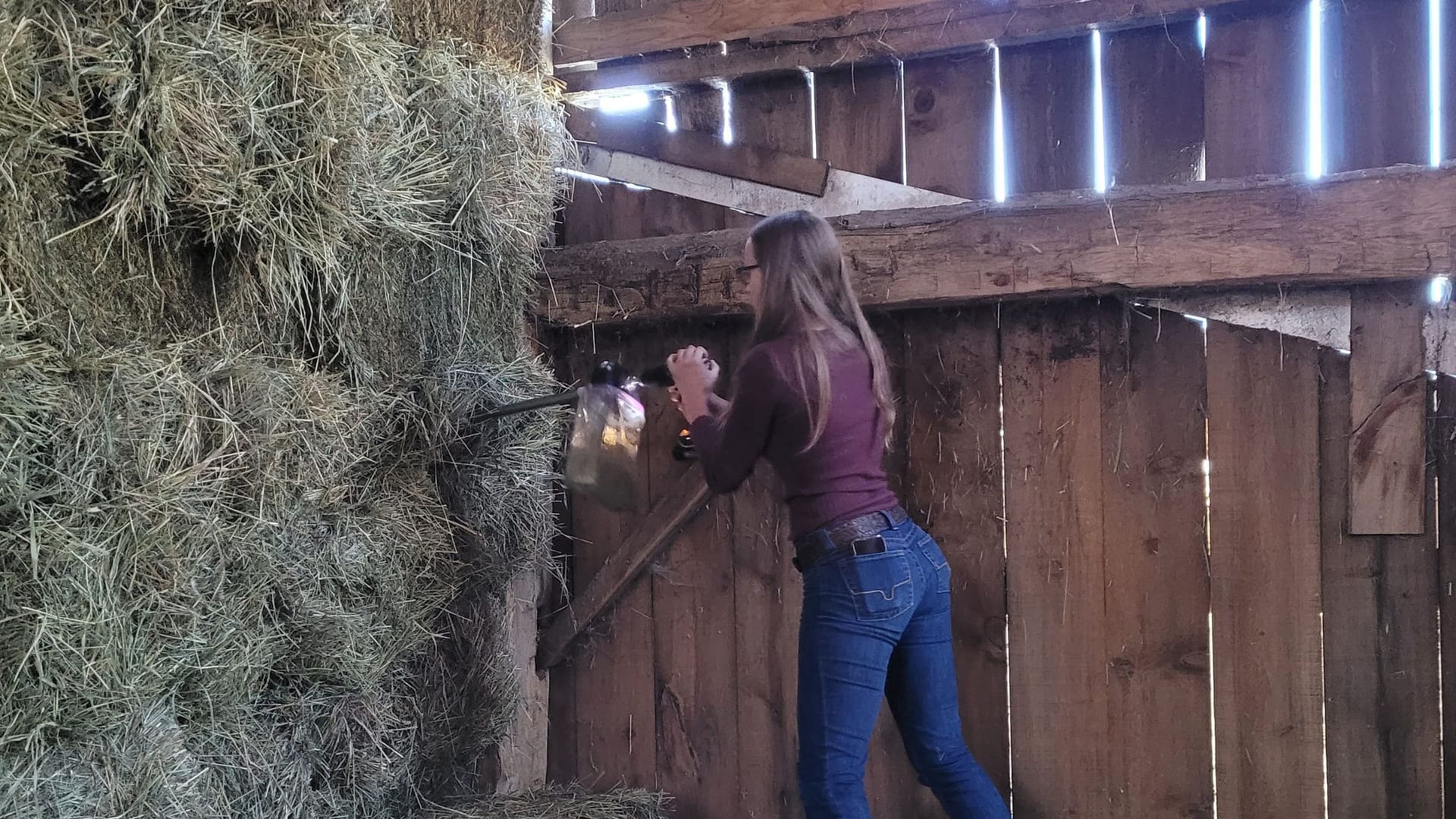2021 vs. 2022
There are many factors that influence the nutritional content of a hay analysis. This is one of the key reasons why it is crucial to get your hay analyzed every year, even if it is being harvested from the same field! Wishing Well Farm harvests their own hay off the same fields every year. This article is going to cover key values to look for in a hay analysis as well as compare the hay analyses from the past two years (2021 vs. 2022). The hay discussed in this article is first-cut grass hay with some alfalfa harvested at Wishing Well Farm.
What to Look for in a Hay Analysis
1. Dry Matter and Moisture Levels
When evaluating a hay analysis, the dry matter and moisture levels are a good place to start. If your hay is too high in moisture, mould will be a concern. But if the moisture level is too low, your leaf content will be brittle and nutrients will be lost. The general range for moisture that is acceptable when testing stored hay is about 6-15%. Ideal moisture for baling the hay is different (typically ~15-20%) and storage conditions can also impact the moisture content. For example, the type of barn and relative humidity of the area can impact moisture. Therefore, when evaluating moisture content, you need to know the context in which the sample was taken to be able to judge if the level is acceptable or not.
2. Protein
The next area that we evaluate is protein. Looking at both the crude protein and soluble protein gives good intel into the protein your horse will be able to receive from the hay. Most horses on a maintenance program need roughly 10% crude protein, but if you have a growing horse or lactating mare, they will require higher protein.
3. Digestibility Parameters
Another important area are the digestibility parameters. This includes the acid detergent fibre (ADF) and the neutral detergent fibre (NDF). ADF is related to digestibility and energy availability. This value should not exceed 45%. The NDF value is often a good estimate of forage intake and gut fill. 40-50% is ideal. Up to 60% is suitable for horses at maintenance, but ideally it should be less than 65%. When you get very high ADF and NDF percentages the digestibility of the hay is poor. Lignin is also included in the digestibility parameters as it gives the percentage of indigestible material.
4. Fat and Energy Content
After evaluating the digestibility, we move on to the fat and energy content of the forage. For fat, we typically see 1-3%. The digestible energy is related to the fat value and indicates the caloric content of the hay. This is an important value as your nutritionist will use this to ensure your horse is receiving adequate energy in their diet. Instead of the digestible energy being given as a percentage, the value specifically tells you how many Mcal/kg are available to the horse.
5. Mineral Content
In addition to the macronutrients previously discussed, the mineral content of the hay is also an important aspect. Ash gives a general measurement of mineral content, but nutritionists will look more closely at the mineral ratios such as calcium to phosphorus. This ratio should be around 2:1, or at minimum be above 1.5, since you want calcium to be higher than phosphorus. Allowing horses to have free-choice access to salt is always recommended, as sodium in forages is normally low.
Another reason to ensure you are looking at the ash content is that high ash percentages can indicate contaminants in the hay from the harvesting equipment. For example, a poorly maintained cutter head on a sickle bar mower conditioner can lead to an increased number of plants being pulled out of the ground and placed into the windrow with the soil still on the plant. Another example is that an improperly adjusted hay rake can scour the ground when raking, picking up material that increases the ash content. Therefore, this value on the hay analysis can also be useful for the hay farmer to help with tracking equipment maintenance and adjustment.
6. Starches and Sugars
A final area to evaluate—that is often of high concern for many horse owners—is the starches and sugars. This is broken down into ethanol soluble carbohydrates (ESC), water soluble carbohydrates (WSC), and starch. Based on some of these values, the non-structural carbohydrate (NSC) content can be calculated. Typically, for a horse with metabolic issues you want to maintain a NSC value below 10%. For horses without metabolic issues a NSC level below 15% is recommended.
Now let’s dive into our comparison of 2021 hay and 2022 hay.
2021 Hay vs. 2022 Hay
| Analysis Component | 2021 Hay Analysis | 2022 Hay Analysis |
|---|---|---|
| Moisture (%) | 7.5 | 13.3 |
| Crude Protein (%) | 9.5 | 10.3 |
| Soluble Protein (%) | 2.5 | 3.1 |
| Acid Detergent Fibre (%) | 42.0 | 38.4 |
| Neutral Detergent Fibre (%) | 67.5 | 66.5 |
| Lignin (%) | 6.6 | 6.0 |
| Fat (%) | 1.9 | 2.5 |
| Digestible Energy (Mcal/kg) | 1.9 | 2.0 |
| Ash (%) | 3.4 | 6.3 |
| Calcium: Phosphorus Ratio | 2.9 | 1.7 |
| Non-Structural Carbohydrates (%) | 16.0 | 13.7 |
The table above highlights some of the key values previously discussed in the article. As you can see from the table, even though this hay is harvested from the same field, the nutrient content varies. Overall, the nutrient content in the 2022 hay is better for this herd of horses. The protein is higher; the ADF, NDF and lignin are lower; and the energy is higher. The mineral content of this hay is also higher despite the calcium to phosphorus ratio being a bit lower in the 2022 hay. The non-structural carbohydrate load is too high for metabolic horses in both years; however, with a herd that does not have any metabolic issues it is still more ideal to have the lower NSC value that the 2022 hay has.

What Changed Between 2021 and 2022?
There are a lot of factors that influence hay quality. The biggest factor is the one that cannot be controlled—the weather. You need rain at the right time to make the fields grow, but you need it to be dry during harvest time. You need several dry days in a row to harvest good hay, and in wet years hay can be late to harvest to the detriment of its quality. However, there are some factors that can be influenced. Wishing Well Farm was able to make some harvesting alterations to strive for an improved nutrient content for their 2022 hay.
This table summarizes differences in the hay harvesting over the years 2021 and 2022.
| Component | 2021 | 2022 |
|---|---|---|
| Weather | Very wet June and July Cool with slow difficult drying | Moderate rain in spring and June Good drying conditions in June and July |
| Crop Conditions | Very tall grass stems in some fields Tall heavy thatch that was tall enough to be incorporated into the hay crop | Very little thatch due to late cutting in previous year Reduced crop height and yield due to reduced rain and fertilizer |
| Timing | Late starting and very late to finish First cut started in late June and did not finish until early August | Started late June Finished mid-July |
| Fertilizer | Full application based on soil tested in early April Well rained in after application | Reduced application due to doubling of cost per tonne Only received light rain after application |
| Equipment | The intermeshing conditioning rollers on haybine was stripping leaves from crop | Timing of intermeshing conditioning rollers adjusted to reduce the stripping of leaves from crop when cutting Newer cutter bar system installed to improve clean cutting of crop |
All the factors discussed above have the potential to largely impact the nutrient content of the hay. The thatch being much more prevalent for the 2021 hay harvesting is likely a key factor that contributed to the higher ADF and NDF values seen in that hay analysis. The equipment adjustments that Wishing Well Farm made likely contributed to the higher moisture as well as nutrient content in the 2022 hay.
In conclusion, it is important to remember that hay is a challenging crop to harvest. All the planning, planting and fertilizer care that goes into the crop can quickly be negatively impacted by poor weather. This is a stressful time of year for hay farmers, especially in bad weather years—they always deserve our empathy and understanding as they try to produce good quality hay for our horses.
References
National Research Council. “Nutrient Requirements of Horses: 2007.”
Nadeau, J. (2006). Hay analysis: Its importance and interpretation.

